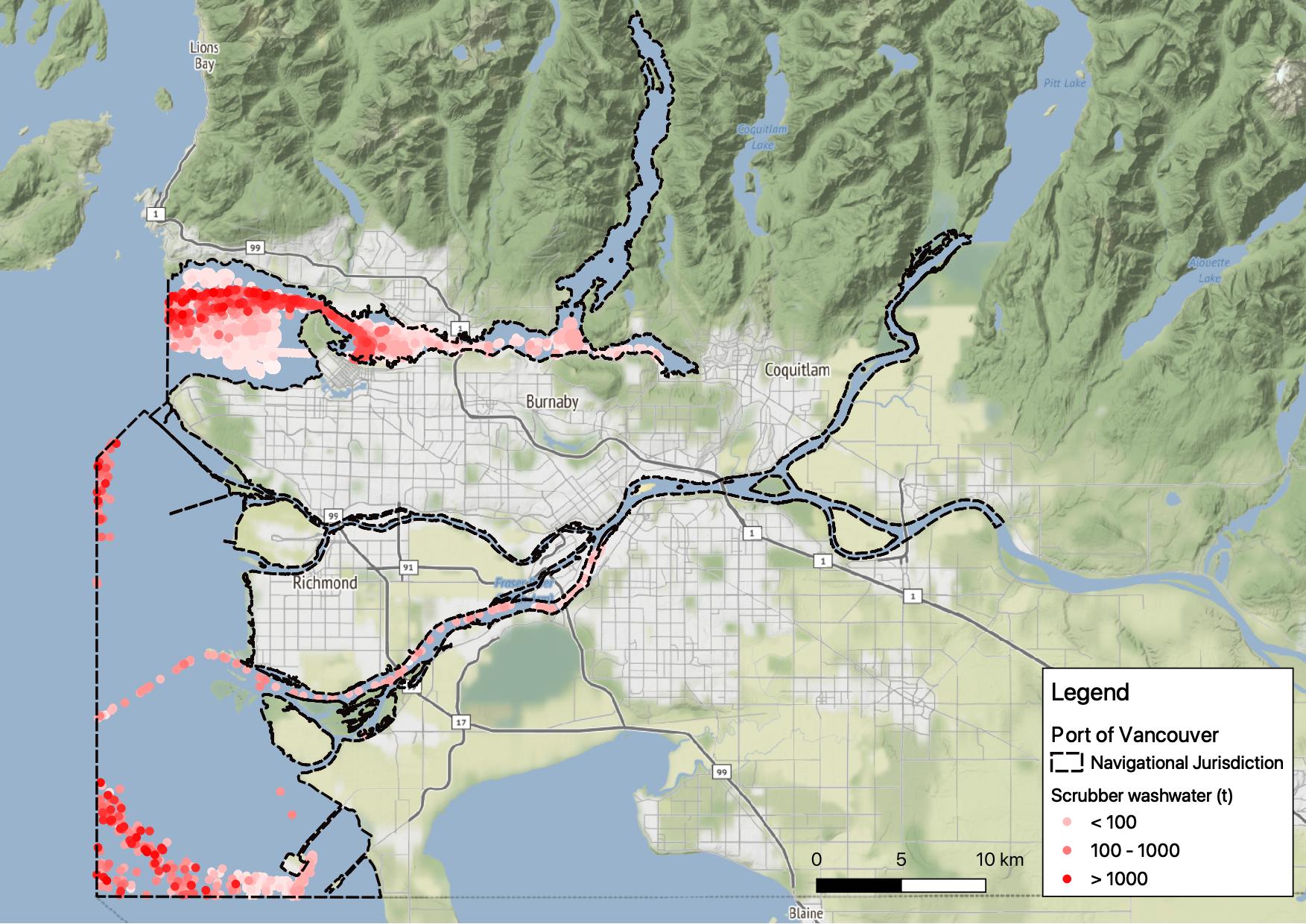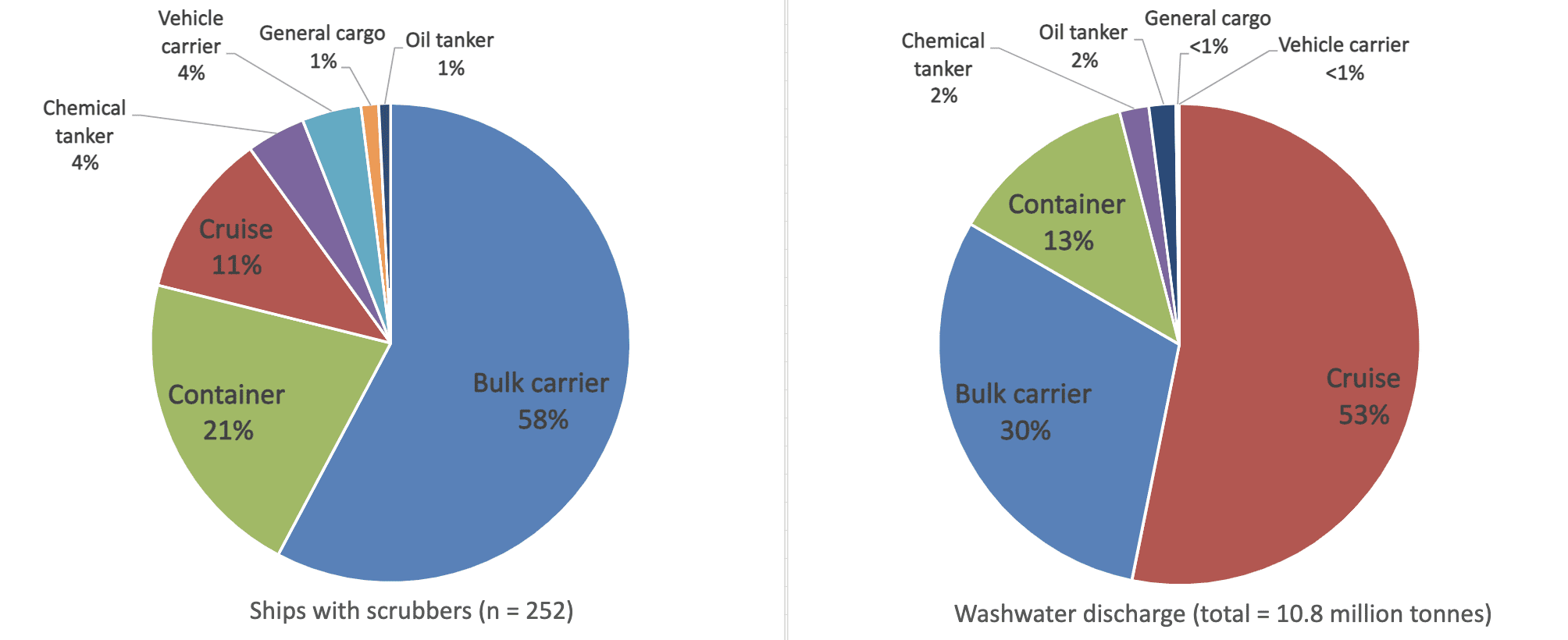Blog
One cruise-ship-sized loophole needs to be closed in Vancouver’s proposed scrubber restrictions
Last May, we wondered if we would soon “B.C.-ing” a scrubber discharge ban in Vancouver. Turns out, yes. But for maximum effect, a cruise-ship-sized loophole needs to be closed before the ban takes effect on March 1, 2022.
On November 24, 2021, the Vancouver Fraser Port Authority issued a Notice of Amendment to its Port Information Guide introducing restrictions on scrubber washwater discharges for ships at-anchor or at-berth. That’s welcome news because, as we found in an April 2021 report, we expect ships with scrubbers to discharge an estimated 5.2 million tonnes (Mt) of washwater within 1 nautical mile of the Port of Vancouver each year, making it the fourth most impacted port in the world. The report recommended that policymakers concerned about the environmental and public health impacts of scrubbers ban scrubber discharges in waters under their jurisdiction.
Since then, the ICCT has estimated potential scrubber washwater discharges within the entire navigational jurisdiction of the Port of Vancouver, using the port limits described in section 7.4 of the Port Information Guide (and also available online in an interactive map—see the “navigational jurisdiction” layer). We found that 252 ships that operated within the port’s navigational jurisdiction in 2019 had installed scrubbers as of the end of 2020. We analyzed 2019 ship activity to represent pre-pandemic traffic and discharge patterns, which served as inputs to our model of the expected level of in-port washwater discharges when traffic returns to normal. This is especially important for cruise ships, which faced restrictions in 2020 but, as of November 1, 2021, are once again allowed in Canadian waters.
Our model finds that these 252 ships are expected to discharge 10.8 Mt of washwater when operating within the navigational jurisdiction of the Port of Vancouver. However, actual discharges may be higher as ships continue to install scrubbers, and because our assumption regarding the scrubber washwater flow rate may be lower than the actual flow rate, as explained in our report. The distribution of expected washwater discharges is shown in Figure 1. We estimate that 88% of the discharges within the port’s navigational jurisdiction would come from ships at anchor or at berth. About half of the scrubber washwater discharges at anchor or at berth are from cruise ships and a third are from bulk carriers.

Figure 1. Modeled washwater discharges within the Port of Vancouver’s navigational jurisdiction, in a post-pandemic year. Sources: Vancouver Fraser Port Authority (navigational jurisdiction boundary); exactEarth (AIS data); IHS (ship characteristics data); Clarkson Research Services (scrubber characteristics data); QGIS (map layers: USA/OSM Stamen Terrain, QGIS OpenLayers plugin). Created by the ICCT.
Of the 252 scrubber-equipped ships we modeled, 226 used open-loop scrubbers, 25 used hybrid scrubbers, and 1 used a closed-loop scrubber; we explained the differences between the scrubbers in an earlier blog post and in our report. By ship type, 145 were bulk carriers, 53 were container ships, and just 28 were cruise ships. Nevertheless, the cruise ships, representing just 11% of the scrubber-equipped ships, would be responsible for 53% of scrubber washwater discharges, because of the relatively large amounts of fuel they use at anchor and at berth to power the ship and its amenities. After cruise ships, the leading sources of washwater discharges are bulk carriers (30%) and container ships (13%), as shown in Figure 2.

Figure 2. Proportion of ships with scrubbers (left) compared to proportion of washwater discharges (right) within the port’s navigational jurisdiction
Under section 56 of the Canada Marine Act, a port authority may establish practices and procedures for the purpose of environmental protection. Here’s how the proposed scrubber restrictions begin:
The discharge of wash water from exhaust gas cleaning systems (EGCS) from all fuel combustion machinery (excluding main engines) into the environment is not permitted while a vessel is at anchorage or at berth within the Port of Vancouver. This applies to the wash water from open-loop and closed-loop EGCS. …
Banning scrubber discharges from ships at-anchor or at-berth is a great first step and would go a long way to protecting the port’s waters, given that 88% of scrubber washwater discharges within the port’s navigational jurisdiction are expected to be from ships at anchor or at berth. It’s also good that the ban applies to both open-loop and closed-loop operations, which we recommended in a 2020 blog post.
The cruise-ship-sized loophole is found in parentheses: “(excluding main engines)”.
Cruise ships, the major culprits in washwater discharges, do not typically have the classic main engine/auxiliary engine configuration of most ships but instead commonly use a diesel-electric setup. Rather than a single large main engine for propulsion and smaller auxiliary engines for electrical power, most cruise ships use several smaller diesel engines for both electricity and propulsion, blurring the line between main engines and auxiliary engines. Because of this more complicated configuration, a cruise ship owner or operator could claim that washwater discharged at anchor or at berth is from main engines and is therefore excluded from the ban and allowed in port waters. This would be contrary to the intent of the proposed restrictions.
To close the loophole, the Vancouver Fraser Port Authority should delete the text “from all fuel combustion machinery (excluding main engines)”. A revised sentence would close the loophole and would be clearer: The discharge of wash water from exhaust gas cleaning systems (EGCS) into the environment is not permitted while a vessel is at anchorage or at berth within the Port of Vancouver. Simple and to the point.
We’ve recommended this change to the port authority in public comments we submitted on the proposed amendments. Those comments also include proposed edits to the restrictions that ensure that discharges from hybrid scrubbers and closed-loop scrubbers are prohibited. They also clarify that vessels must switch to compliant fuel if the EGCS cannot be operated in zero-discharge mode. The port authority is taking public comments through January 8, 2022.
On the day the Port Authority made public its partial ban on scrubber discharges, it also published (but has yet to post on its website) a fact sheet that apparently envisions two follow-on phases. The second phase would prohibit discharges in all waters within the Port Authority’s jurisdiction and the third phase would prohibit the use of scrubbers within the same area, presumably to protect air quality. Extending the restriction to all ships whenever they are within port waters would prevent washwater discharges while ships are transiting, entering, or exiting the navigational jurisdiction of the port, offering additional protection. While we estimated that 88% of discharges would be from ships at anchor or at berth, more than 1.25 Mt of washwater would be from ships sailing at maneuvering or cruising speeds.
The third phase, which bans the use of all scrubbers—even closed-loop in zero-discharge mode—would help protect air quality. In a consulting report prepared for Environment and Climate Change Canada, we found that using scrubbers is not as effective at reducing air pollution as using lower sulfur fuels such as marine gas oil. Using heavy fuel oil with a scrubber resulted in lower sulfur dioxide emissions than marine gas oil but higher particulate matter and black carbon emissions, as well as higher direct and life-cycle carbon dioxide emissions. Requiring ships to use fuels that comply with the North American Emission Control Area, such as marine gas oil, rather than heavy fuel oil with a scrubber, would help protect air quality near the port and reduce climate pollution. The key will be to engage not only with industry, but also with researchers and civil society, to determine when phase two and three ought to be implemented.
Ultimately, we think the Port of Vancouver should ban the use of scrubbers within its navigation jurisdiction. In phase one, it should close the cruise-ship loophole by deleting the “excluding main engines” text, and it should move to phase two and three as soon as possible to achieve maximum water quality and air quality protections. Policymakers in other jurisdictions could follow the Port of Vancouver’s lead and ban the use of scrubbers in their waters as well.
